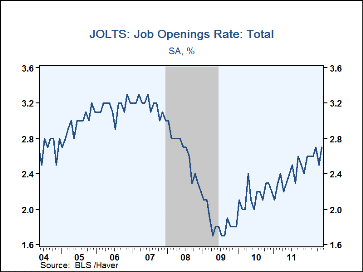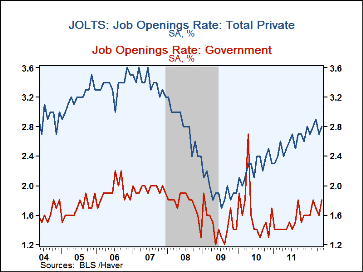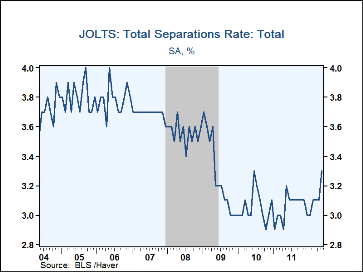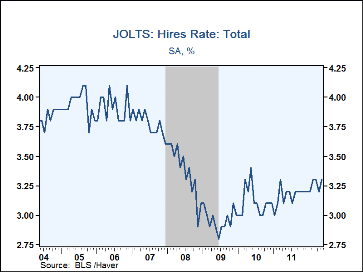 Global| Jul 10 2012
Global| Jul 10 2012U.S. JOLTS: Job Openings Rebound
by:Tom Moeller
|in:Economy in Brief
Summary
The rate of labor market improvement rose during May. The Bureau of Labor Statistics indicated in its Job Openings & Labor Turnover Survey (JOLTS) that the rate of 2.7% reversed its April decline and was improved versus the recession [...]
The rate of labor market improvement rose during May. The Bureau of Labor Statistics indicated in its Job Openings & Labor Turnover Survey (JOLTS) that the rate of 2.7% reversed its April decline and was improved versus the recession low of 1.6%. The job openings rate is the number of job openings on the last business day of the month as a percent of total employment plus job openings. The actual number of job openings in May rose 5.7% from April (18.4% y/y).
The private-sector job openings rate rose m/m to 2.8% and has moved steadily higher versus the recession low of 1.7%. The professional & business services job openings rate ticked up to 3.7%. The rate in education & health services also inched up to 3.3%. In manufacturing the rate rose to a five year high of 2.5% and made up its April decline. The job openings rate in government recovered to 1.8%, its best since the 2010 Census.
Employment gains also increased as the hires rate recovered to 3.3%. The hires rate is the number of hires during the month divided by employment. The hires rate in the private sector rose to 3.7% and the government's rate inched up to 1.4%. The factory sector hires rate was stable at 2.2%, about where it's been since 2009. Overall hires in the private sector recovered 3.8% (3.6% y/y) while in the public sector they inched up 0.3% (15.5% y/y). Leisure & hospitality business hires rose 13.1% y/y while hires in education & health services increased 14.5% y/y. Hires in professional & business services rose a lesser 1.5% y/y while in manufacturing they declined 4.1% y/y.
The job separations rate rose to 3.3% after three months at 3.1% and the actual number of separations rose 4.1% y/y. Separations include quits, layoffs, discharges, and other separations as well as retirements. The layoff & discharge rate alone jumped to 1.4% its highest since last June. The private sector layoff rate was 1.6% while in government it was 0.6%.
The JOLTS survey dates only to December 2000 and the figures are available in Haver's USECON database.
| JOLTS (Job Openings & Labor Turnover Survey) | May | Apr | Mar | May'11 | 2011 | 2010 | 2009 |
|---|---|---|---|---|---|---|---|
| Job Openings, Total | |||||||
| Rate (%) | 2.7 | 2.5 | 2.7 | 2.3 | 2.6 | 2.2 | 1.8 |
| Total (000s) | 3,642 | 3,447 | 3,741 | 3,014 | 3,540 | 2,902 | 2,432 |
| Hires, Total | |||||||
| Rate (%) | 3.3 | 3.2 | 3.3 | 3.2 | 38.0 | 37.4 | 35.5 |
| Total(000s) | 4,361 | 4,213 | 4,335 | 4,182 | 50,006 | 48,647 | 46,386 |
| Layoffs & Discharges, Total | |||||||
| Rate (%) | 1.4 | 1.3 | 1.2 | 1.4 | 15.6 | 16.7 | 20.5 |
| Total (000s) | 1,885 | 1,743 | 1,652 | 1,843 | 20,678 | 21,737 | 26,731 |
Tom Moeller
AuthorMore in Author Profile »Prior to joining Haver Analytics in 2000, Mr. Moeller worked as the Economist at Chancellor Capital Management from 1985 to 1999. There, he developed comprehensive economic forecasts and interpreted economic data for equity and fixed income portfolio managers. Also at Chancellor, Mr. Moeller worked as an equity analyst and was responsible for researching and rating companies in the economically sensitive automobile and housing industries for investment in Chancellor’s equity portfolio. Prior to joining Chancellor, Mr. Moeller was an Economist at Citibank from 1979 to 1984. He also analyzed pricing behavior in the metals industry for the Council on Wage and Price Stability in Washington, D.C. In 1999, Mr. Moeller received the award for most accurate forecast from the Forecasters' Club of New York. From 1990 to 1992 he was President of the New York Association for Business Economists. Mr. Moeller earned an M.B.A. in Finance from Fordham University, where he graduated in 1987. He holds a Bachelor of Arts in Economics from George Washington University.










